Symbolizing strength and sacrifice, bulls in the Bible hold deep spiritual significance, inviting exploration into their sacred roles and enduring legacy.
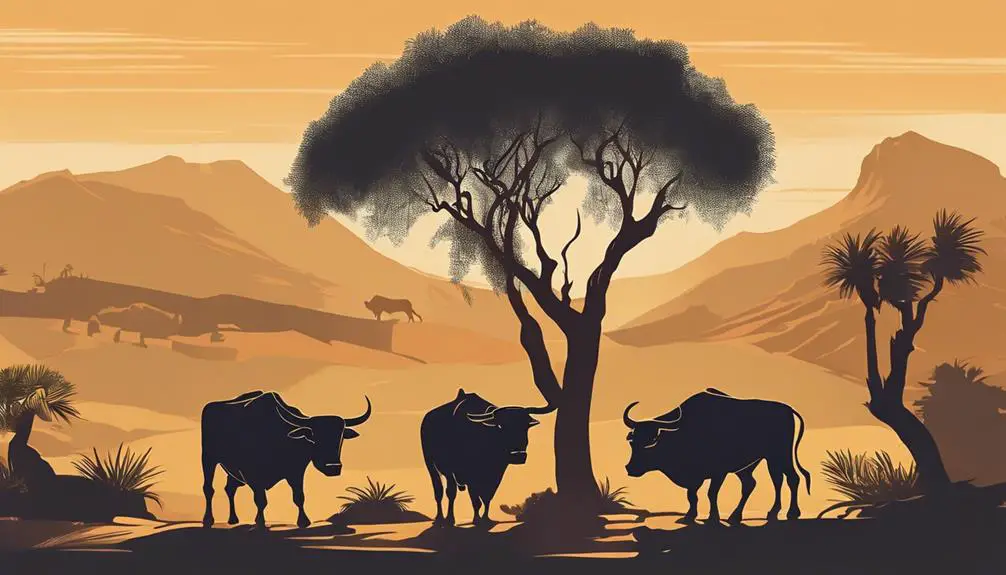
Bulls in the Bible
As you navigate through the tapestry of biblical narratives, you'll find that bulls aren't just animals grazing in the fields of ancient texts; they're potent symbols woven into the fabric of spiritual and cultural life.
You're about to uncover the layers of meaning behind the bulls used in sacrificial rites, the infamous Golden Calf incident, their appearances in prophetic visions, and their significance within the broader cultural contexts.
This journey will not only illuminate the historical and religious significance of these creatures but also invite you to ponder on their enduring legacy in today's world.
Why do you think bulls were chosen for such pivotal roles, and what can their stories tell us about the societies that venerated them?
Key Takeaways
- Bulls symbolize strength, fertility, and sacrificial purity in biblical narratives.
- Bull sacrifices were central to seeking divine favor and community purification.
- The Golden Calf incident highlights the consequences of idolatry and leadership challenges.
- Prophetic visions involving bulls convey messages of judgment, divine power, and renewal.
Symbolic Meanings of Bulls
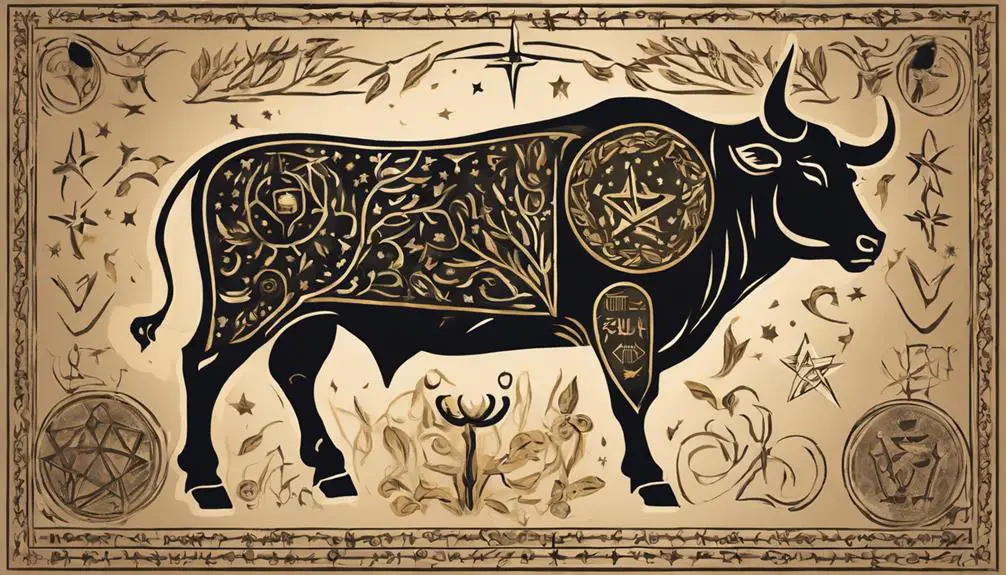
In the biblical context, bulls carry profound symbolic meanings, often representing strength, fertility, and sacrifice. When you delve into the scriptures, you'll notice that bulls aren't merely animals; they embody significant theological and cultural themes. Their recurrent appearances aren't arbitrary; they're imbued with layers of symbolism that reflect ancient beliefs and values.
Bull strength is a prominent motif throughout biblical narratives. This isn't just physical prowess but a symbol of divine power and protection. When you encounter references to bulls, it's often in contexts that emphasize God's strength and the robustness of His followers. This imagery would have resonated deeply with ancient societies, where physical strength was crucial for survival and prosperity. Thus, the bull becomes a metaphor for spiritual resilience and steadfast faith.
Fertility symbolism associated with bulls is equally significant. In agrarian societies, fertility was paramount, not just for crops but for animals and people too. Bulls, with their vital role in reproduction and their association with plowing fields, naturally emerged as symbols of fertility and abundance. In biblical texts, fertility is often linked to divine blessings and promises of prosperity. The bull, therefore, transcends its literal role, embodying hopes for growth, renewal, and the continuation of lineage.
These layers of meaning attributed to bulls in the Bible offer a rich tapestry of symbolism. They're not just historical references but are woven into the very fabric of biblical theology, reflecting the complex interplay between the divine, the natural world, and human society. Understanding these symbols helps you appreciate the depth and breadth of biblical literature, revealing insights into ancient spiritual and cultural perspectives.
Bulls in Sacrificial Rites
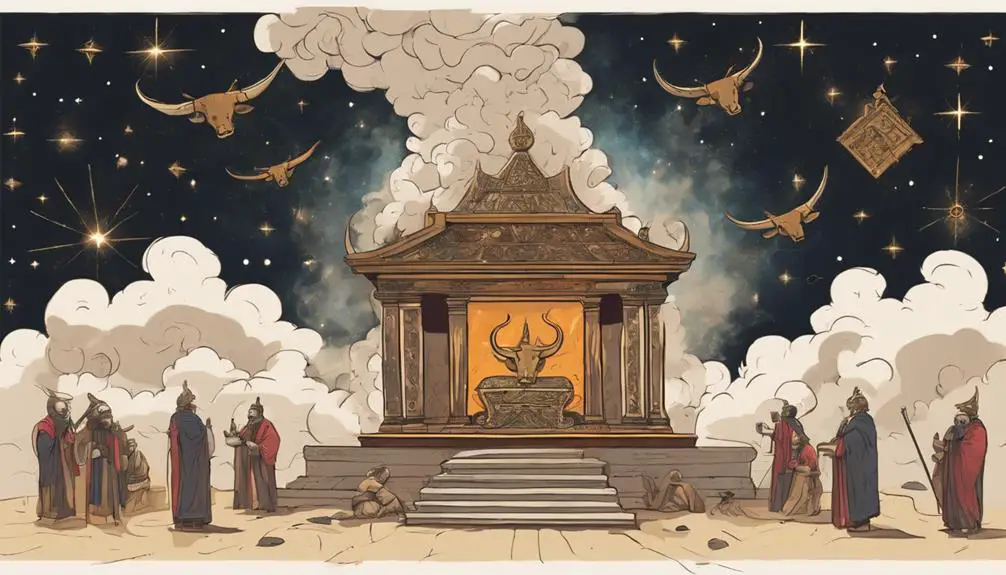
Delving into the realm of sacrificial rites, you'll find that bulls played a pivotal role, symbolizing not just wealth and honor but also serving as essential offerings to seek divine favor and atonement. The selection and preparation of these animals weren't arbitrary; they adhered to stringent criteria and elaborate ritual preparations, underscoring the seriousness and sanctity of these acts.
Bull selection criteria were meticulous, emphasizing the animal's physical perfection and symbolic purity. A bull intended for sacrifice had to be without blemish, embodying the idea of an unblemished offering to a divine entity. This requirement wasn't merely about the animal's aesthetics but signified the worshipper's sincere intention to present the best and purest to God. The choice of a bull, often among the most valuable assets in ancient societies, further highlighted the sacrificer's devotion and willingness to part with significant wealth for spiritual reconciliation and benediction.
Ritual preparations were equally rigorous, involving not just the physical preparation of the bull but also the purification of those involved in the rite. These preparations served to sanctify the act, distinguishing it from ordinary slaughter. The rituals often included ablutions, fasting, and prayers, emphasizing the spiritual over the physical act. The meticulous nature of these preparations underscored the belief that proper conduct and intention were crucial for the sacrifice's acceptance.
Through these practices, bulls in sacrificial rites represented a complex interplay of religious belief, societal values, and spiritual aspiration. The careful selection and preparation of these animals underscored the community's reverence for divine laws and their earnest quest for spiritual purity and divine favor.
The Golden Calf Incident
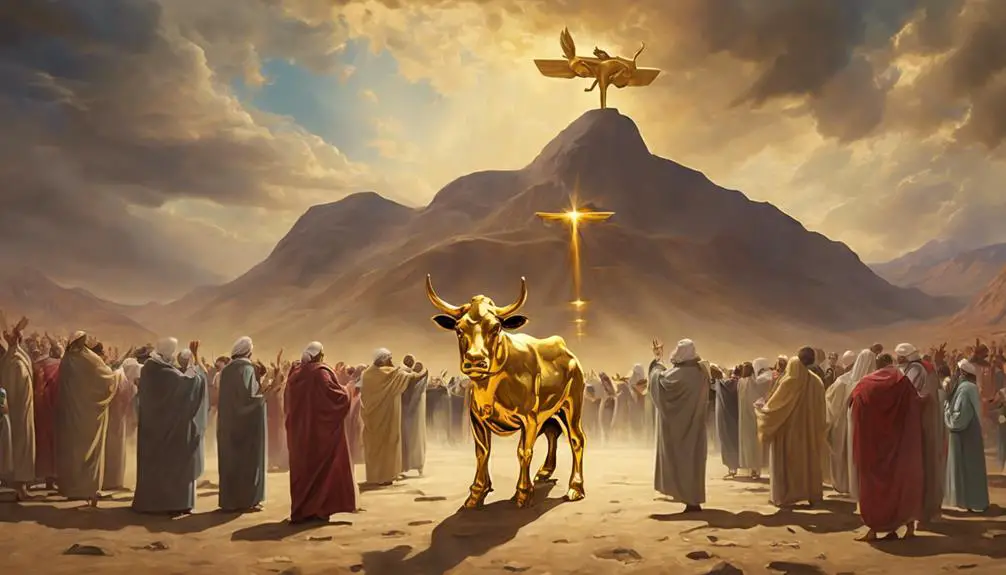
While bulls often symbolized divine favor in sacrificial rites, the Golden Calf incident starkly illustrates how their image could also underpin significant spiritual transgression and confrontation. This narrative isn't just about idol worship; it's a profound exploration of idolatry consequences and the leadership challenges it poses. When you delve into this episode, you see a community at a spiritual crossroads, grappling with faith, patience, and authority.
- The Israelites, feeling abandoned by Moses, demand a tangible god, leading to the creation of the Golden Calf.
- Aaron, faced with leadership pressure, capitulates, illustrating the vulnerability and responsibility of those in power.
- Moses' descent from Mount Sinai, tablets in hand, becomes a defining moment of confrontation and decision.
- The subsequent destruction of the calf and the punishment of the idolaters underscore the severe consequences of straying from faith.
- The intercession of Moses on behalf of the Israelites highlights the complexities of leadership in times of spiritual crisis.
This incident reflects the perils of forgetting one's spiritual heritage and the ease with which people can be led astray in the absence of strong, principled leadership. It serves as a cautionary tale about the consequences of idolatry, not just in terms of divine retribution, but also in the erosion of community trust and cohesion. Moreover, it presents a nuanced view of leadership, showing that true leaders must navigate between the demands of their followers and the dictates of their conscience, often under the most challenging circumstances.
Prophetic Visions and Bulls
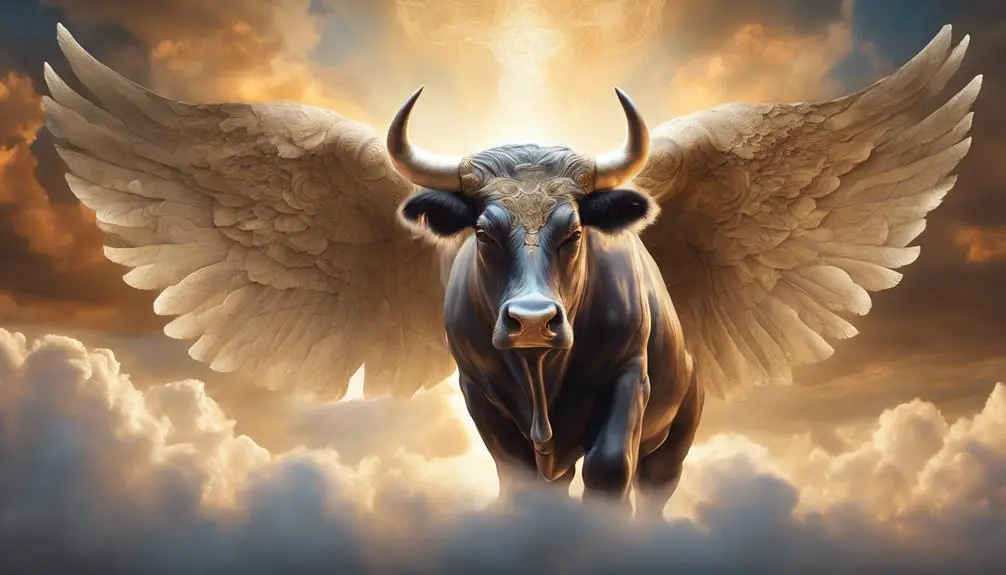
Bulls, emblematic of strength and fertility, frequently surface in prophetic visions within biblical texts, serving as potent symbols that elucidate divine messages and human destiny. These appearances aren't arbitrary; they're steeped in the cultural and religious ethos of the times, offering a rich tapestry for vision interpretation. You'll find that the context in which bulls appear often speaks volumes about the message being conveyed.
In analyzing bull appearances in prophetic visions, it's crucial to consider the attributes traditionally associated with these animals. Their strength isn't merely physical but symbolic of divine power and judgement. For instance, when prophets describe visions of bulls, you're invited to delve deeper into the narrative, discerning not just the immediate scenario but the broader divine communication at play. These visions often serve as metaphors for impending judgement, calls to repentance, or assurances of divine intervention.
Moreover, the fertility aspect associated with bulls contributes to their symbolic significance in visions, often representing hope for renewal and future prosperity. When interpreting these visions, you're encouraged to look beyond the surface, understanding the fertility symbol as a promise of rebirth and divine provision.
In your journey through biblical texts, you'll notice that the interpretation of these prophetic visions isn't always straightforward. It requires a nuanced understanding of the historical and cultural contexts, as well as a deep engagement with the symbolic language of the Bible. Bulls in prophetic visions aren't just animals; they're multidimensional symbols woven into the fabric of divine communication, offering insight into God's will and the path of human destiny.
Bulls in Cultural Contexts
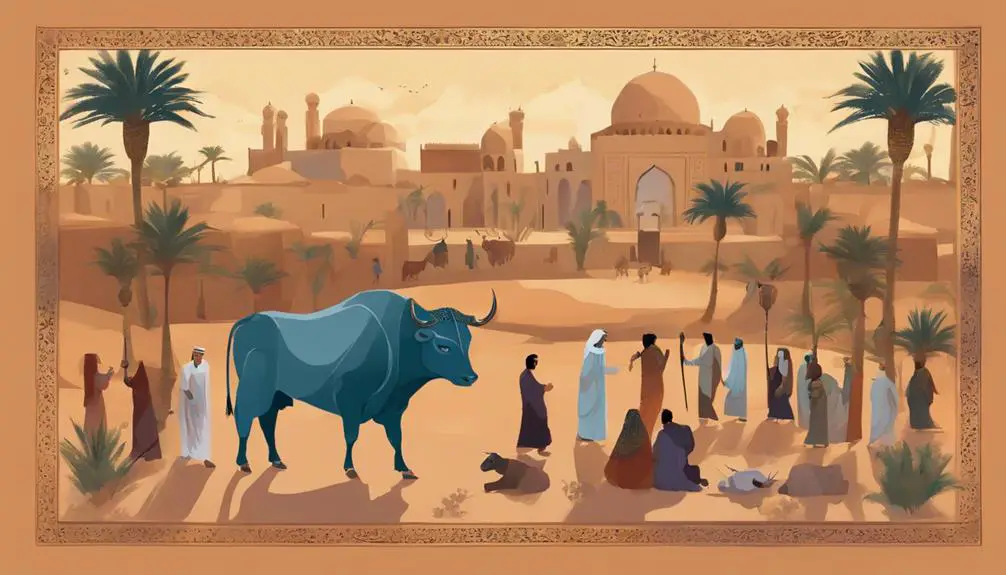
Exploring the significance of bulls in biblical prophetic visions leads us naturally to examine their broader role within ancient cultural contexts, where they weren't merely livestock but pivotal symbols of societal values and religious practices. In these societies, you'd find bulls at the heart of numerous traditions, serving as emblems of strength, fertility, and divine protection. Their depiction across various cultures sheds light on their multifaceted significance and the universal reverence they commanded.
- Bull wrestling: An ancient sport demonstrating human dominance over nature, often linked to rites of passage or kingship ceremonies.
- Zodiac Taurus: Representing reliability, power, and abundance, this constellation highlights the bull's astrological importance and its influence on human behavior and destiny.
- Fertility rituals: Bulls were central to ceremonies invoking agricultural bounty, their virility symbolizing potent life forces and renewal.
- Sacrificial rites: As offerings to deities, bulls embodied the community's devotion and plea for divine favor, a testament to their perceived sacredness.
- Bull iconography in art and sculpture: Symbolizing protection and strength, their images adorned temples, palaces, and public spaces, reinforcing their status as protectors and benefactors.
Analyzing these cultural manifestations, you'll recognize the bull's role transcending mere animalistic representation. Instead, they were intertwined with humanity's deepest existential concerns and aspirations. From bull wrestling to their representation in the Zodiac Taurus, bulls encapsulated the essence of the societies that revered them, reflecting their beliefs, values, and connections to the divine.
Frequently Asked Questions
How Did the Ancient Israelites Differentiate Between Bulls Meant for Agricultural Work and Those Designated for Religious Ceremonies?
To differentiate between bulls for agricultural work and those for religious ceremonies, you'd need to understand bull symbolism and agricultural innovations.
Agriculturally, bulls were chosen for their strength and endurance, critical for plowing and other tasks.
For religious ceremonies, the selection was steeped in symbolism, often involving purity and specific physical traits dictated by religious texts.
This distinction reflects a deep understanding of the roles animals played in both practical and spiritual realms.
Were There Specific Breeds of Bulls Considered More Sacred or Valuable for Biblical Times' Religious Practices, and if So, What Were They?
You're delving into whether certain breeds of bulls held a higher sacred status or value for religious practices. In this analysis, bull symbolism and sacred colors play a pivotal role.
Notably, there isn't clear evidence pointing to specific breeds being more revered. Instead, attributes like color and physical condition likely influenced their sacredness.
This approach suggests a broader, symbolic significance rather than a preference for particular breeds in religious contexts.
How Did the Feeding and Care Practices for Bulls in Biblical Times Compare to Modern Standards for Livestock?
You're exploring how ancient bull diets and care practices relate to modern standards. Back then, bulls' diets were simpler, often limited to what was naturally available, contrasting sharply with today's tailored nutritional plans. Modern parallels show a significant evolution in understanding animal health and dietary needs.
Care practices have also shifted, with contemporary methods emphasizing veterinary care and welfare standards, marking a profound evolution from the more basic, survival-oriented approaches of biblical times.
In Biblical Narratives, Are There Any Accounts of Individuals Forming Personal Attachments or Bonds With Bulls, Similar to How People Today Might With Pets or Specific Farm Animals?
You're diving into an ocean of narratives, seeking pearls of personal anecdotes where humans bond with bulls, akin to modern attachments to pets.
In this exploration, bull symbolism often overshadows individual relationships, suggesting a cultural barrier to personal connections.
Yet, despite this, the search for stories revealing personal bonds illuminates the complexity of human-animal relationships across ages, offering insightful contrasts and reflections on how we perceive and relate to animals.
Beyond Their Religious Significance, What Roles Did Bulls Play in the Economic and Trade Systems of Biblical Societies?
You're exploring how bulls influenced economic and trade systems, beyond their religious importance.
Bull iconography wasn't just symbolic; it signified wealth and power, often influencing trade routes and economic exchanges.
These animals were pivotal in agricultural practices, bolstering economies. Their strength made them assets in both farming and transportation, integrating deeply into trade networks.
As you delve deeper, you'll find their role was multifaceted, intertwining with society's economic foundations.
Conclusion
In analyzing the multifaceted roles of bulls within biblical narratives, it's evident they're not merely animals but potent symbols interwoven with spiritual, cultural, and prophetic significance.
Take, for instance, the Golden Calf incident, a profound lesson on idolatry's peril and faith's fragility. This episode underscores the bulls' emblematic role as a pivot between divine wrath and mercy, urging a deeper reflection on the nuances of faith and devotion.
Thus, bulls transcend their literal presence, embodying complex theological themes and human dilemmas.


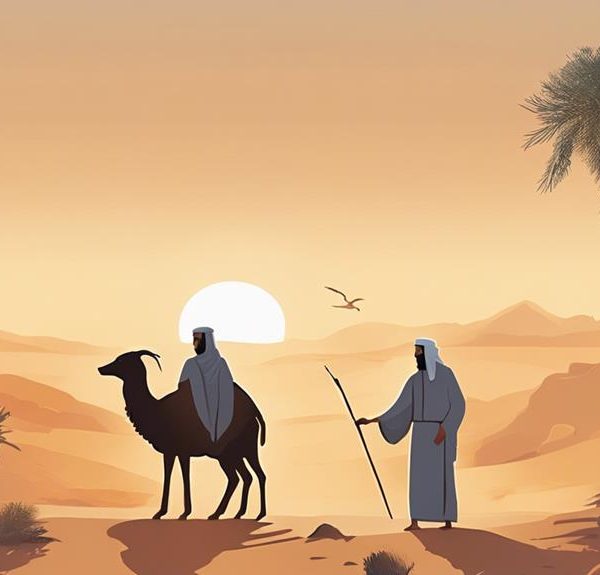
Sign up